
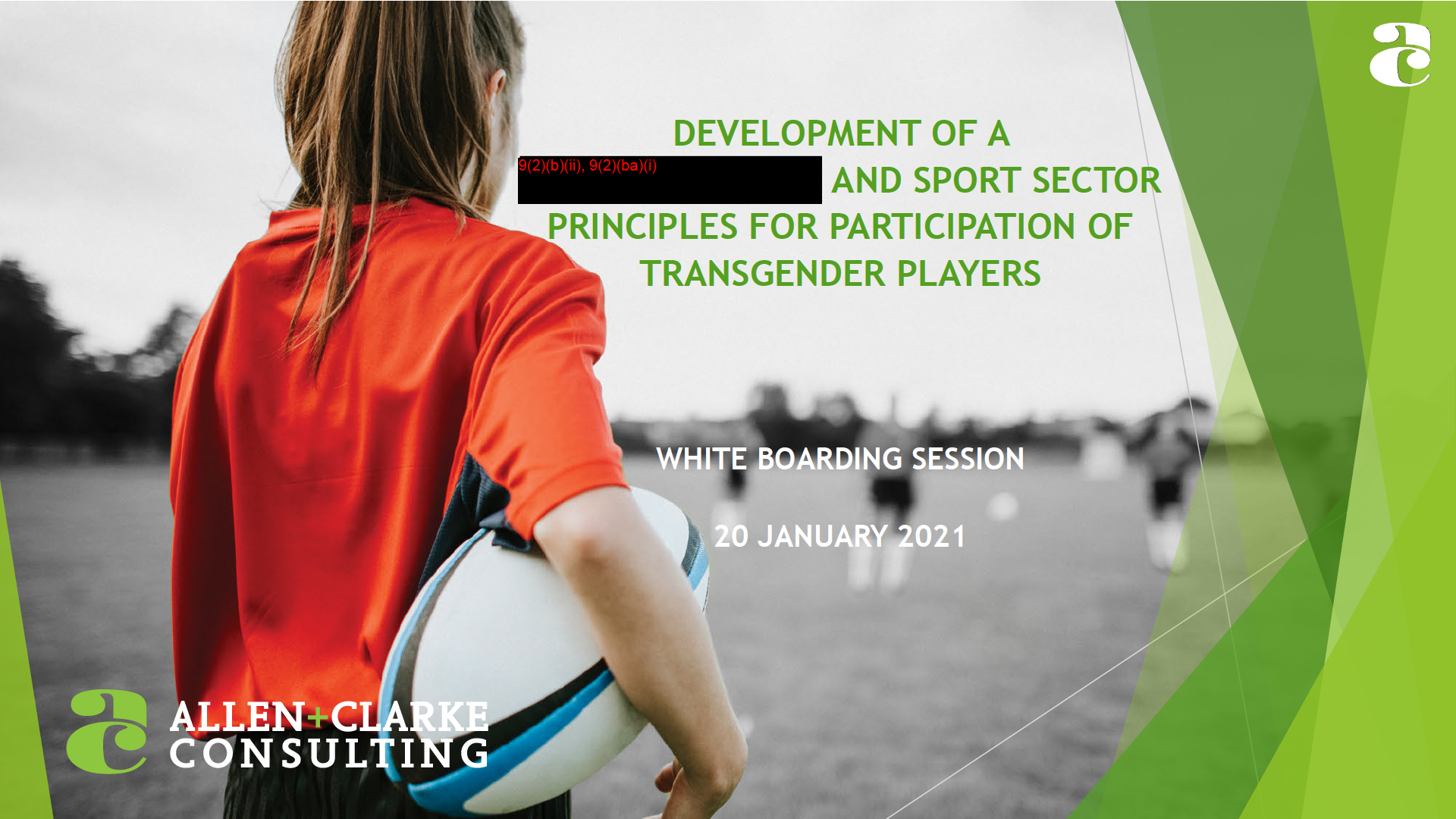
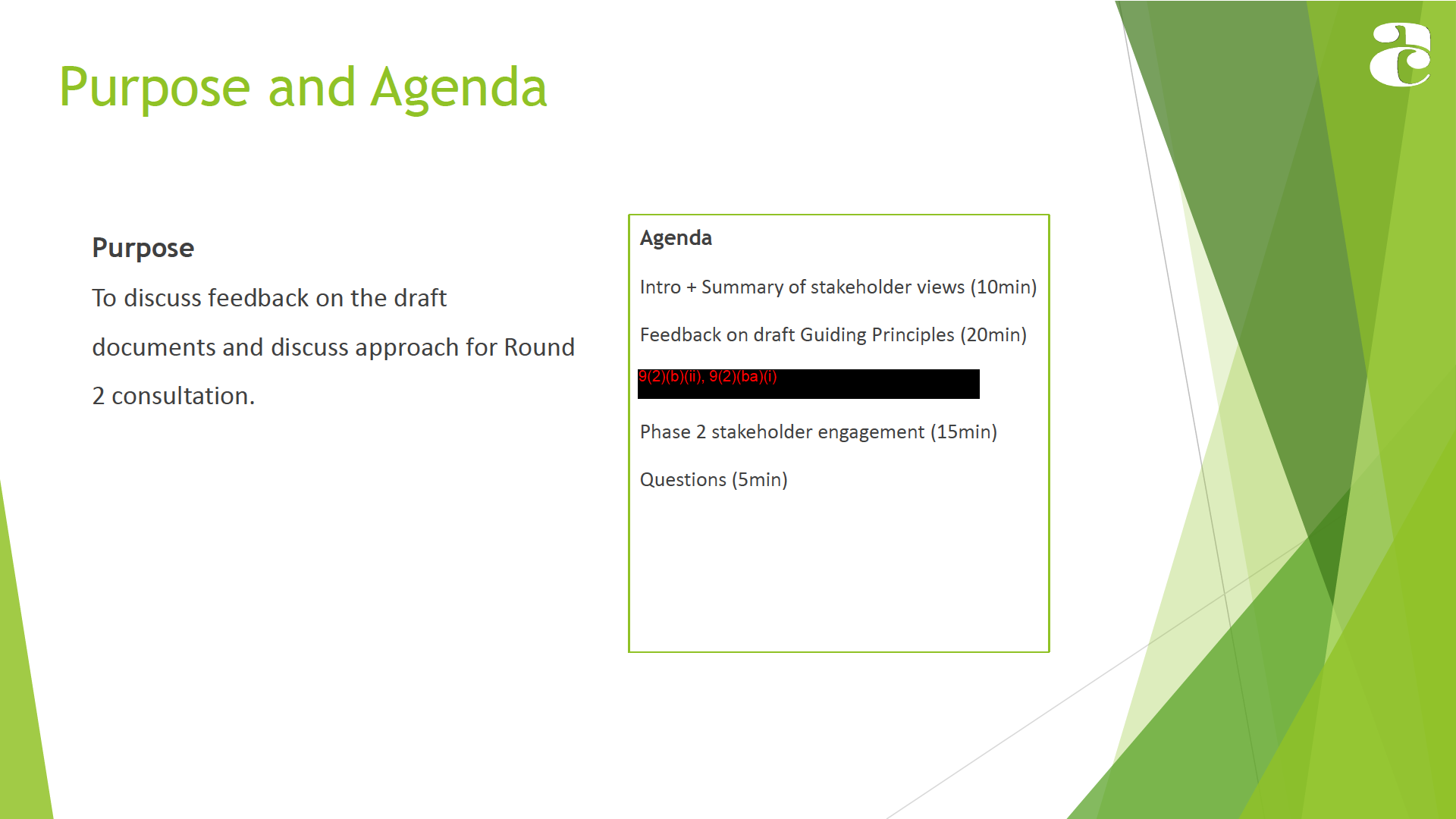
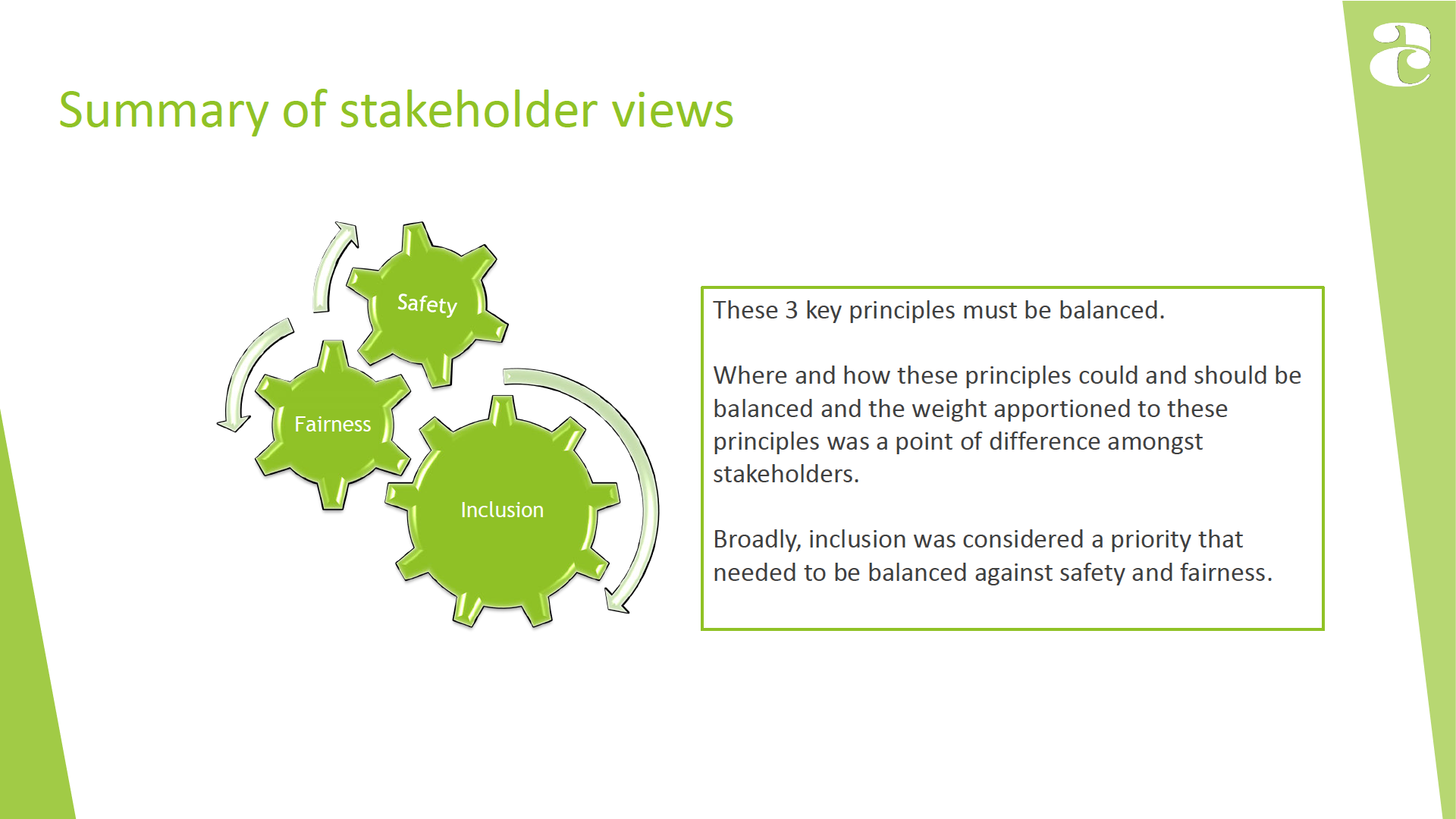
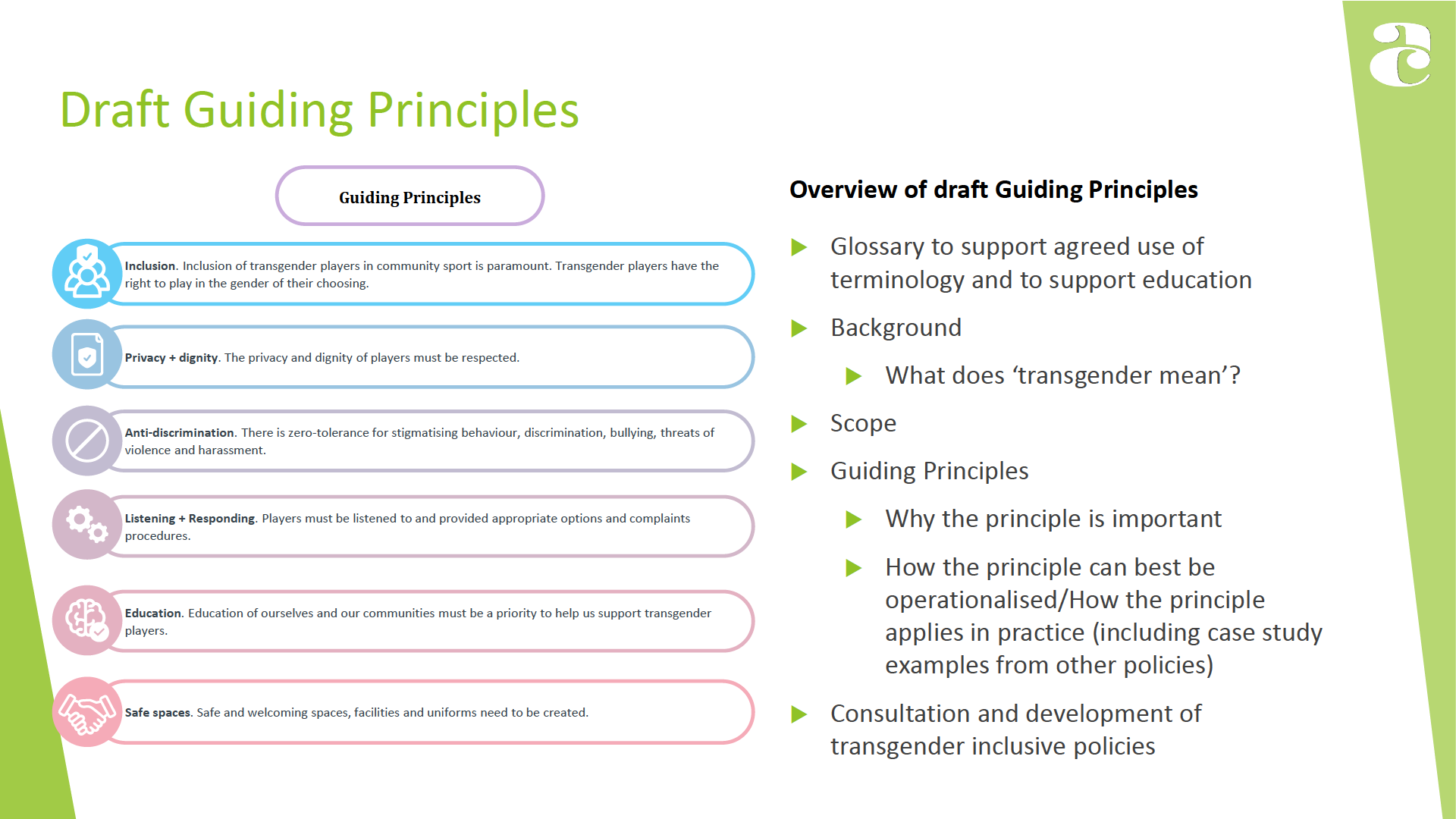



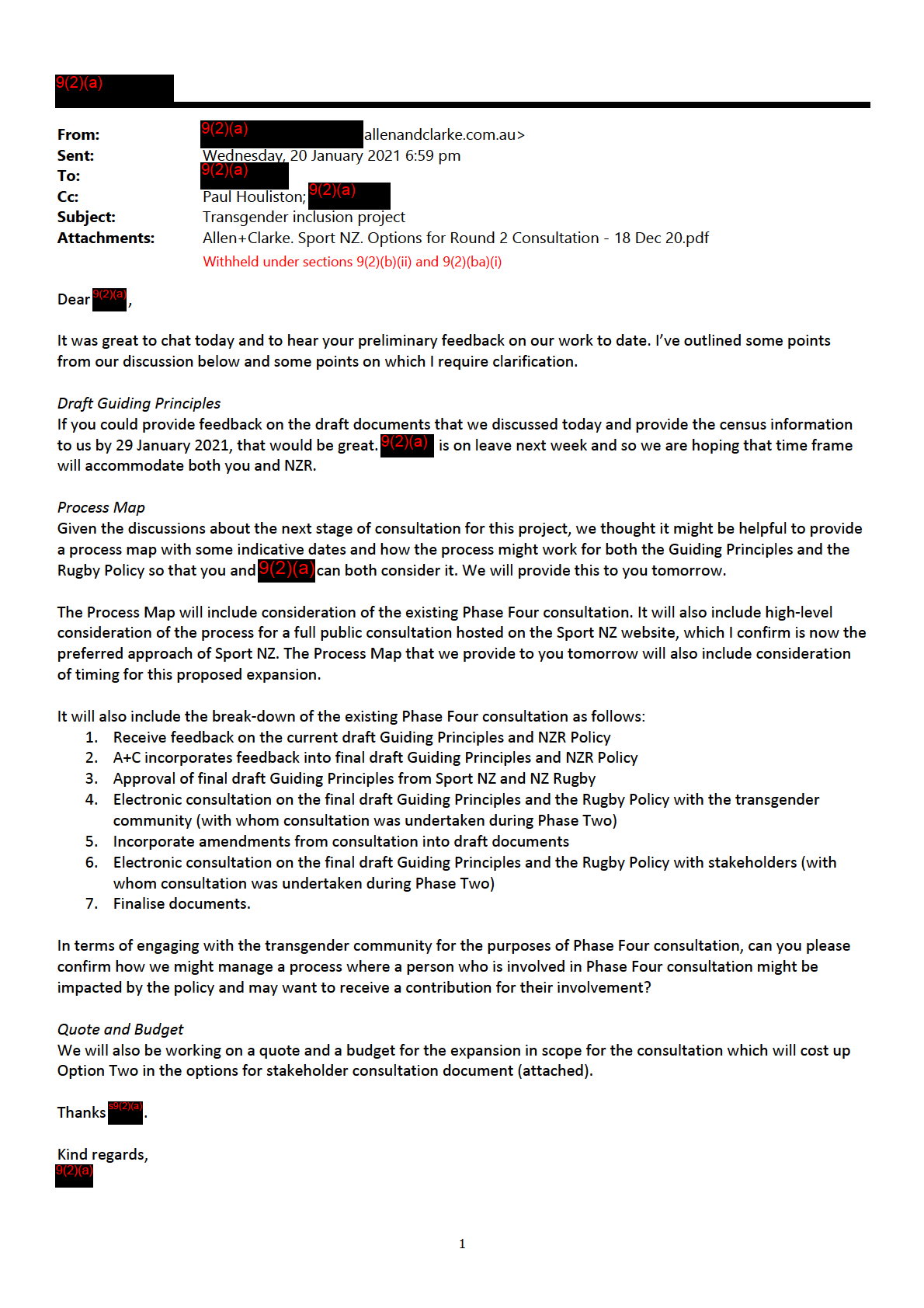

9(2)(a)
Manager
Ph. 9(2)(a)
9(2)(a) @allenandclarke.com.au
Suite 203, 546 Collins St, Melbourne VIC 3000
www.allenandclarke.com.au
Allen + Clarke acknowledges the Traditional Custodians of the land we work on and the
communities that we work with. We acknowledge their history, culture and Elders past, present
and emerging.
At A+C we work flexibly. While it suits me to email now, I don’t anticipate a response outside of
your normal working hours.
Please consider the environment before printing this email.
This email message and any attachment are intended only for the addressee. The contents of the
email may be confidential. If you have received this email in error, please notify the sender and
delete the email and any attachments.
∙ ∙ ∙ ∙ ∙ ∙ ∙ ∙ ∙ ∙ ∙ ∙ ∙ ∙ ∙ ∙ ∙ ∙ ∙ ∙ ∙ ∙ ∙ ∙ ∙ ∙ ∙ ∙ ∙ ∙ ∙ ∙ ∙ ∙ ∙ ∙ ∙ ∙ ∙ ∙ ∙ ∙ ∙ ∙ ∙ ∙
2


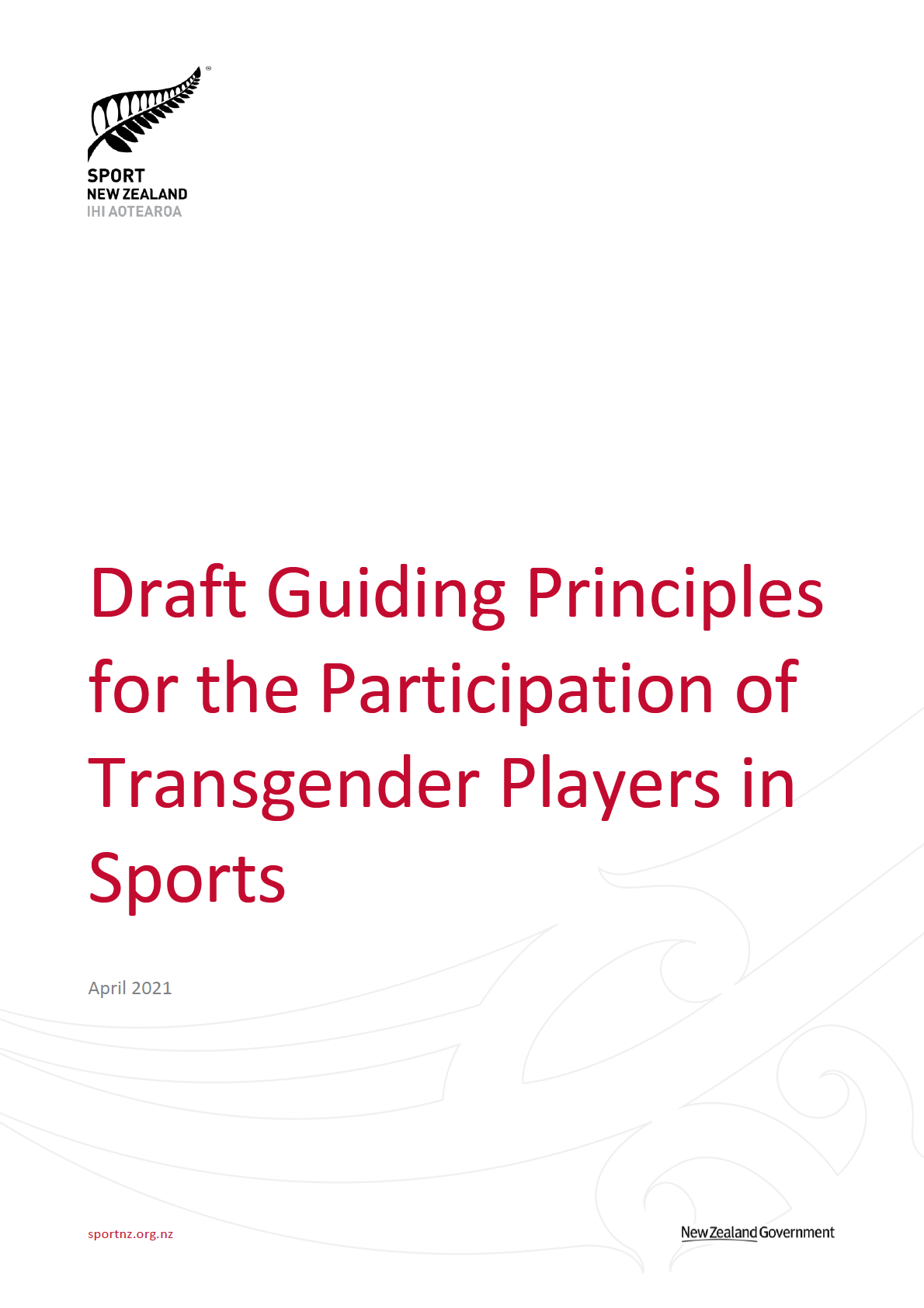

3
Contents
Glossary....................................................................................................................... 4
1.
Introduction.......................................................................................................... 9
1.1.
Background .......................................................................................................................... 10
1.1.1. What does ‘transgender’ mean? ............................................................................................ 10
1.2.
Scope ................................................................................................................................... 10
2.
Guiding Principles ............................................................................................... 12
2.1.
Inclusion. .............................................................................................................................. 12
2.1.1. Why is this important? ......................................................................................................... 12
2.1.2. How can this best be operationalised? How does this apply in practice? ..................................... 13
2.2.
Wellbeing + Safety ............................................................................................................... 15
2.2.1. Why is this important? ......................................................................................................... 15
2.2.2.
How can this best be operationalised? How does this apply in practice? .................................. 15
2.3.
Privacy + Dignity ................................................................................................................... 17
2.3.1. Why is this important? ......................................................................................................... 17
2.3.2.
How can this best be operationalised? How does this apply in practice? .................................. 17
2.4.
Anti-discrimination, Bullying and Harassment ....................................................................... 21
2.4.1. Why is this important? ......................................................................................................... 21
2.4.2.
How can this best be operationalised? How does this apply in practice? .................................. 22
2.5.
Listening + Responding ......................................................................................................... 24
2.5.1. Why is this important? ......................................................................................................... 24
2.5.2.
How can this best be operationalised? How does this apply in practice? .................................. 24
2.6.
Education ............................................................................................................................. 25
2.6.1. Why is this important? ......................................................................................................... 25
2.6.2.
How can this best be operationalised? How does this apply in practice? .................................. 25
2.7.
Safe Spaces........................................................................................................................... 28
2.7.1. Why is this important? ......................................................................................................... 28
2.7.2.
How can this best be operationalised? How does this apply in practice? .................................. 28
3.
Consultation and development of transgender inclusive policies .............................. 30
3.1.
Consultation ......................................................................................................................... 30
3.2.
Drafting considerations ........................................................................................................ 31
3.3.
Content ................................................................................................................................ 31
3.4.
Supporting implementation .................................................................................................. 33
3.5.
Further support and assistance ............................................................................................. 33
sportnz.org.nz
Draft Guiding Principles for the Participation of Transgender Players in Sports – April 21
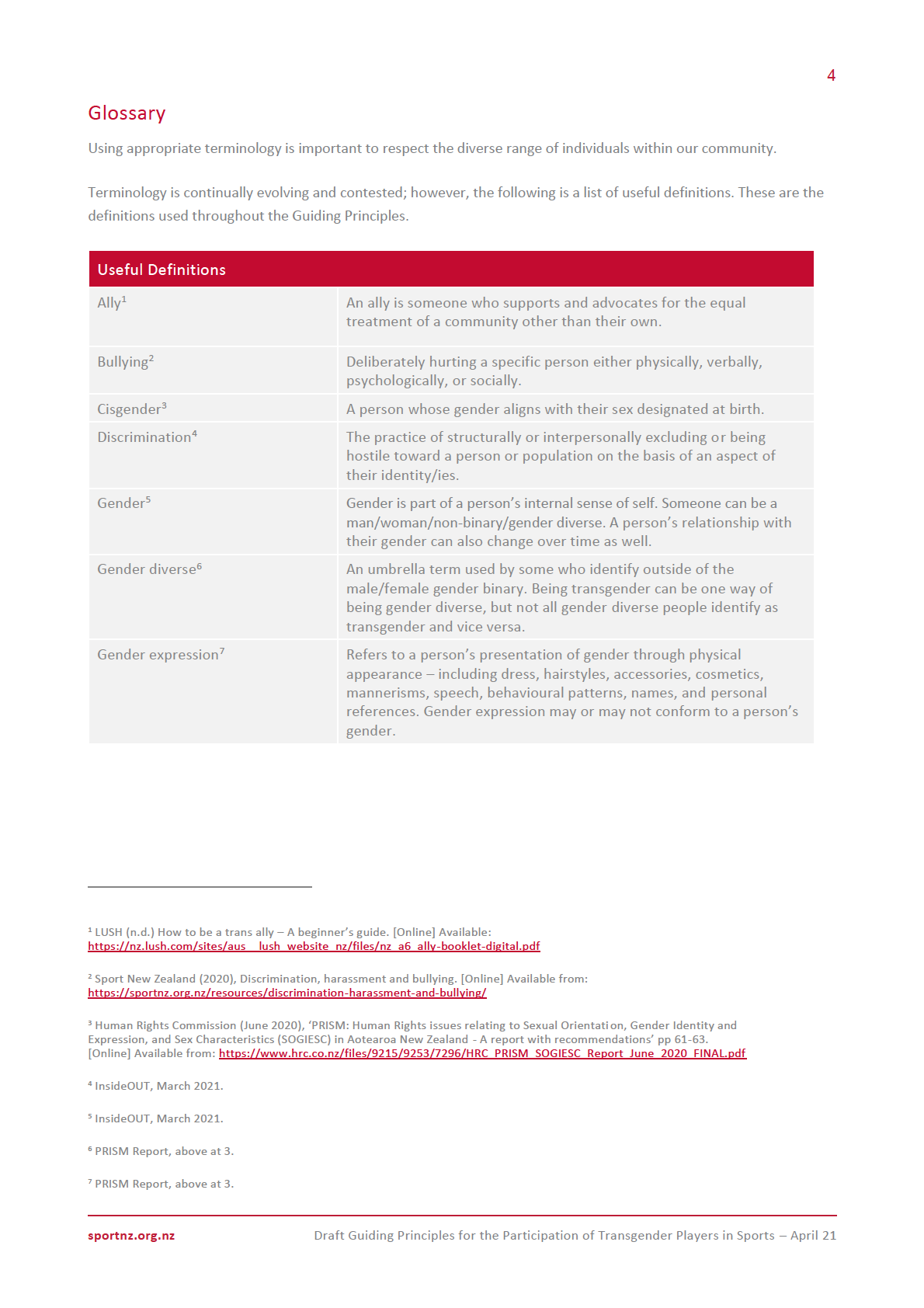
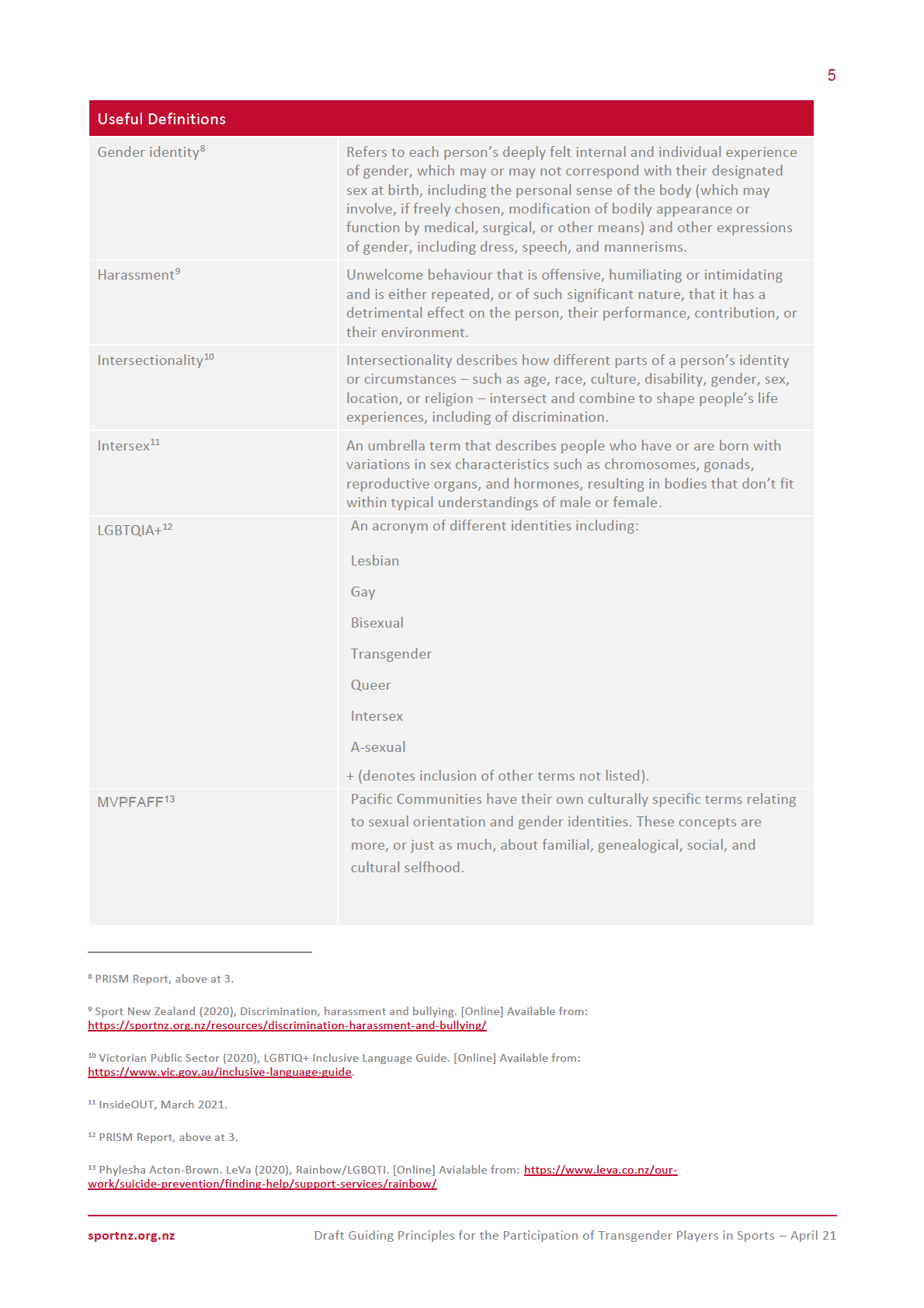

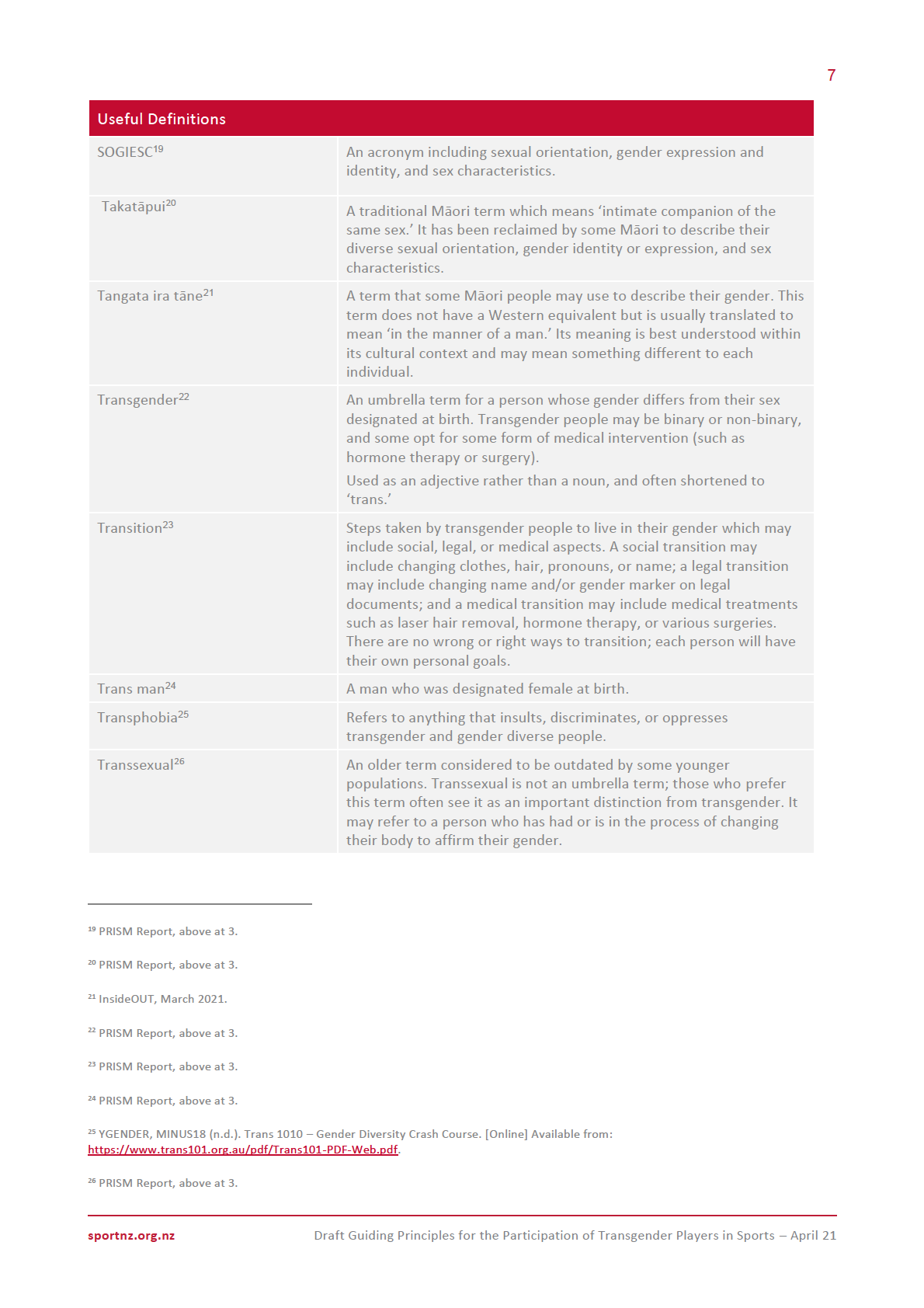
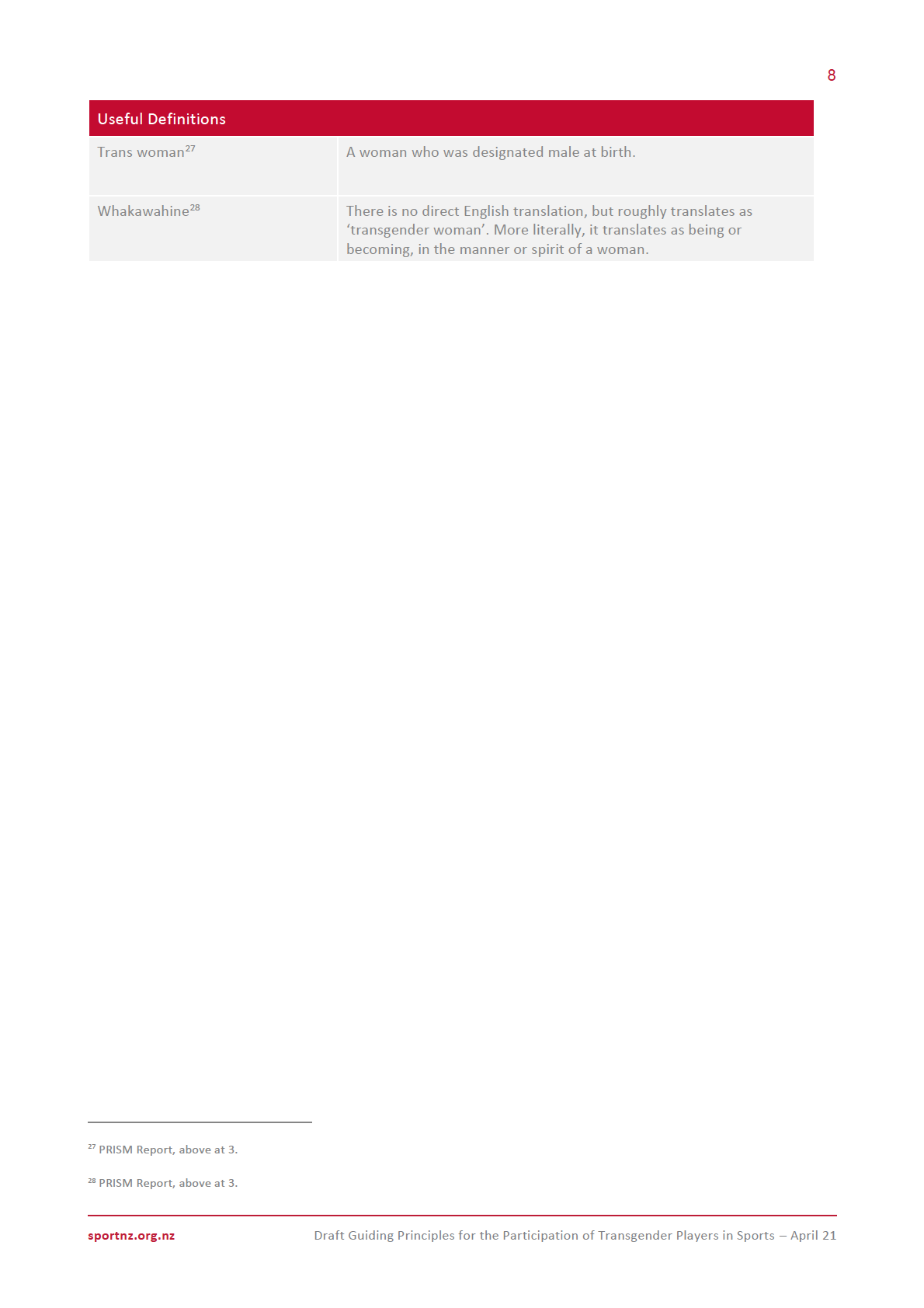

10
1.1. Background
The following Guiding Principles have been established following stakeholder engagement with members of the
transgender and sporting communities, academics, researchers, and other advocacy groups. The Guiding
Principles have also been informed by international sporting policies that are transgender inclusive.
The Guiding Principles: discuss the importance of each Principle to help assist understanding amongst sporting
codes, provide tangible examples to support operationalisation of these policies, and inc lude scenarios to
support sporting codes with the implementation of the relevant Principles.
1.1.1. What does ‘transgender’ mean?
For the purposes of the Guiding Principles the term ‘transgender’ is used as an umbrella term for a person whose
gender differs from their sex designated at birth.29 We intend for this term to include Pacific communities such
as MVPFAFF.30
Gender is part of a person’s internal sense of self. It can be female, male, neither, a combination of the two, or
exist completely outside of that. Sex however is usually determined by genitalia. A person’s gender therefore
may or may not align with their designated sex at birth.
Transitioning describes the steps taken by transgender people to live in their gender which may include social,
legal, or medical aspects, or may simply be a personal and private decision made by an individual. There is no
single approach to transition and no specific set of steps is necessary to ‘complete’ a transition.
A social transition may include changing clothes, hair, pronouns, or name; a legal transition may include
changing name and/or gender marker on legal documents; and a medical transition may include medical
treatments such as hair removal, hormone therapy, or various surgeries. There a re no wrong or right ways to
transition; each person will have their own personal goals and take varying actions as part of their transition.
These may be obvious, or they may be very subtle, based on the person’s individual choice. Transgender
individuals may choose to share this information and their transition process with others, or they may choose to
keep it confidential.
1.2. Scope
The scope of this work is focussed on community level sport in New Zealand, for all transgender players (both
youth and adult). It is accepted that young people compete in different leagues and formats compared to adults
for many sports. Principles and policies that are developed therefore need to be cognisant of this fact, as those
developed for adults may not be appropriate in addressing the issue of inclusion for young people.
Research into the physiology of transgender sports players and impact of transitioning (for those going through a
medical transition) is currently unsettled. The Guiding Principles accept that further research is continuing to be
established and that any guidance will need to be regularly updated to reflect this.
Sport celebrates diversity in players. Community sport includes participants with a range of abilities and
physiques. Some sports already have mechanisms in place (such as age grades and weight ranges) to address any
relevant disparity of players, protect the health and safety of participants, and provide fair and meaningful
competition.
29 PRISM Report, above at 3.
30 MVPFAFF is an acronym to describe Pasifika identities Mahu (Hawai’i and Tahiti), Vaka sa lewa lewa (Fiji), Palopa (Papua New Guinea),
Fa’afafine (Samoa & American Samoa), Akava’ine (Rarotonga), Fakaleiti/Leiti (Tonga), Fakafifine (Niue).
sportnz.org.nz
Draft Guiding Principles for the Participation of Transgender Players in Sports – April 21
11
Exclusion from sport can have significant disempowering impacts on transgender, gender diverse and non-binary
people, resulting in negative impacts on both mental and physical health.31 These Guiding Principles are based
on the premise that unsettled science around the physiology of transgender players at the community level
creates no legitimate exception to a duty of meaningful inclusion of every individual in the community sport of
their choosing.32 To support diversity and inclusion in the broader community, the transgender community
needs inclusion in sport to be actively fostered. The foundation of these Guiding Principles is therefore one of
inclusivity.
It is recognised that at the elite level, sporting codes will be guided by their relevant international sporting body.
Sports are encouraged to have discussions with transgender players about the implications of the talent pathway
so that individuals can make informed decisions when entering the sport.
These Guiding Principles accept that inclusion of players in community sport should be considered t hrough an
intersectional lens. Intersectionality describes how different parts of a person’s identity or circumstances – such
as age, race, culture, disability, gender, sex, location, or religion – all intersect and combine to shape people’s
life experiences. These Guiding Principles have been developed on the assumption that community sports will
consider intersectionality in the development of their policies.
31
Hargie OD, Mitchell DH, Somerville IJ. ‘People have a knack of making you feel excluded if they catch on to your
difference’: Transgender experiences of exclusion in sport. International Review for the Sociology of Sport.
2017;52(2):223-239. doi:10.1177/1012690215583283.
32 United Nations High Commissioner for Human Rights Report (2020), ‘Intersection of race and gender discrimination in sport’, p 7.
sportnz.org.nz
Draft Guiding Principles for the Participation of Transgender Players in Sports – April 21


13
These results suggest that fear of discrimination and concerns about eligibility limi t the opportunities of
transgender people to have equal access to sports. This is concerning as exclusion from sport can have
significant disempowering impacts on transgender people, negatively impacting both mental and physical
health.36
A good sport is an inclusive sport. This not only reflects the core value of inclusion but reflects the ever -changing
diversity of our local communities which should be welcomed and celebrated. The transgender community live,
work and play across New Zealand and it is important that all our sporting community reflect this.
2.1.2. How can this best be operationalised? How does this apply in practice?
Establishing an inclusive transgender player policy shows a genuine commitment to ensuring that transgender
players are able to take part in sport. It can help indicate to transgender people that they are welcome,
encourage them to remain engaged in the sport and provide guidance to staff and volunteers on how to include
transgender players and how to appropriately respond to any questions that may arise.
An inclusive transgender policy would allow for players to compete in the gender with which they identify and
not the sex they were designated at birth. It would not ask people to prove or otherwise justify their gender.
Example from: Touch Football Australia: 37
For all Touch Football Australia Affiliate competitions, an individual can participate in the
competition/category which best reflects their gender identity.
36
Hargie OD, Mitchell DH, Somerville IJ. ‘People have a knack of making you feel ex cluded if they catch on to your difference’: Transgender
experiences of exclusion in sport. International Review for the Sociology of Sport. 2017;52(2):223-239. doi:10.1177/1012690215583283.
37 Touch Football Australia (2020)
Participation Guidelines for the Inclusion of Transgender and Gender Diverse People in Touch Football
Affiliates.
sportnz.org.nz
Draft Guiding Principles for the Participation of Transgender Players in Sports – April 21

14
An inclusive transgender policy would also include a clear statement and/or objectives that promotes the inclusion of
transgender players.
Example from Touch Football Australia:38
• To affirm our commitment to supporting the inclusion of transgender and gender diverse
identifying people in Touch Football Australia.
• To ensure we foster a safe, welcoming environment for gender-diverse people by eliminating
discriminative behaviour within our facilities, programs, and services.
• To affirm our support of gender affirming practices in our programs, operations, and
competitions.
• To promote a safe, inclusive, and welcoming environment that engages and keeps participants
with diverse genders and sexualities involved in Touch Football.
Scenario of the benefit of an inclusive transgender policy:
• Ra is a transgender male. He loves tennis but has not played since he transitioned because he
does not want to have to provide proof of identification. The sex listed on Ra’s birth certificate
and drivers licence differs to his gender identity.
• Ra looks at the application criteria for local tennis clubs and finds one that says all players can
participate in the gender with which they identify. Ra calls up the club manager and asks if he
can sign up to the men’s league.
• The club manager is warm and welcoming and helps Ra process his application.
To ensure that sports are inclusive of transgender, gender diverse and non-binary people it is essential that those
who lead sporting bodes (for example the Board) are committed to the inclusion of transgender, gender diverse and
non-binary players.
Example of what leadership demonstrating inclusion could involve:
• A written commitment in governance processes that the Board will take steps to welcome and
include transgender players in their sport and the broader sporting community .
• Actively engaging in the education of players, coaches, staff, and members by providing them
with information in induction packs about how to support transgender players.
• Supporting and paying for members to take part in educational rainbow workshops.
• Appointment of an inclusion officer as a point of contact and support for transgender players.
38 Touch Football Australia (2020)
Participation Guidelines for the Inclusion of Transgender and Gender Diverse People in Touch Football
Affiliates.
sportnz.org.nz
Draft Guiding Principles for the Participation of Transgender Players in Sports – April 21


16
Active steps
In addition to a transgender inclusion policy, further steps can be taken by sporting providers and organisations
(such as clubs, schools and other sporting bodies) to support the health, safety and wellbeing of all players,
including transgender, gender diverse and non-binary players.
Example of active steps that can be taken to support the health, safety, and wellbeing of players:
• Regularly checking that equipment, facilities and programmes meet health and safety standards.
• Having mechanisms in place to allow players to compete safely and ensure the competition is
comprised of an appropriately similar cohort of players, for example weight bands and age
brackets.
• Appointing a wellbeing officer who is a point of contact and oversees player welfare.
• Providing an anonymous suggestion box so that the community can suggest changes that would
enhance the sport and its members experiences.
sportnz.org.nz
Draft Guiding Principles for the Participation of Transgender Players in Sports – April 21
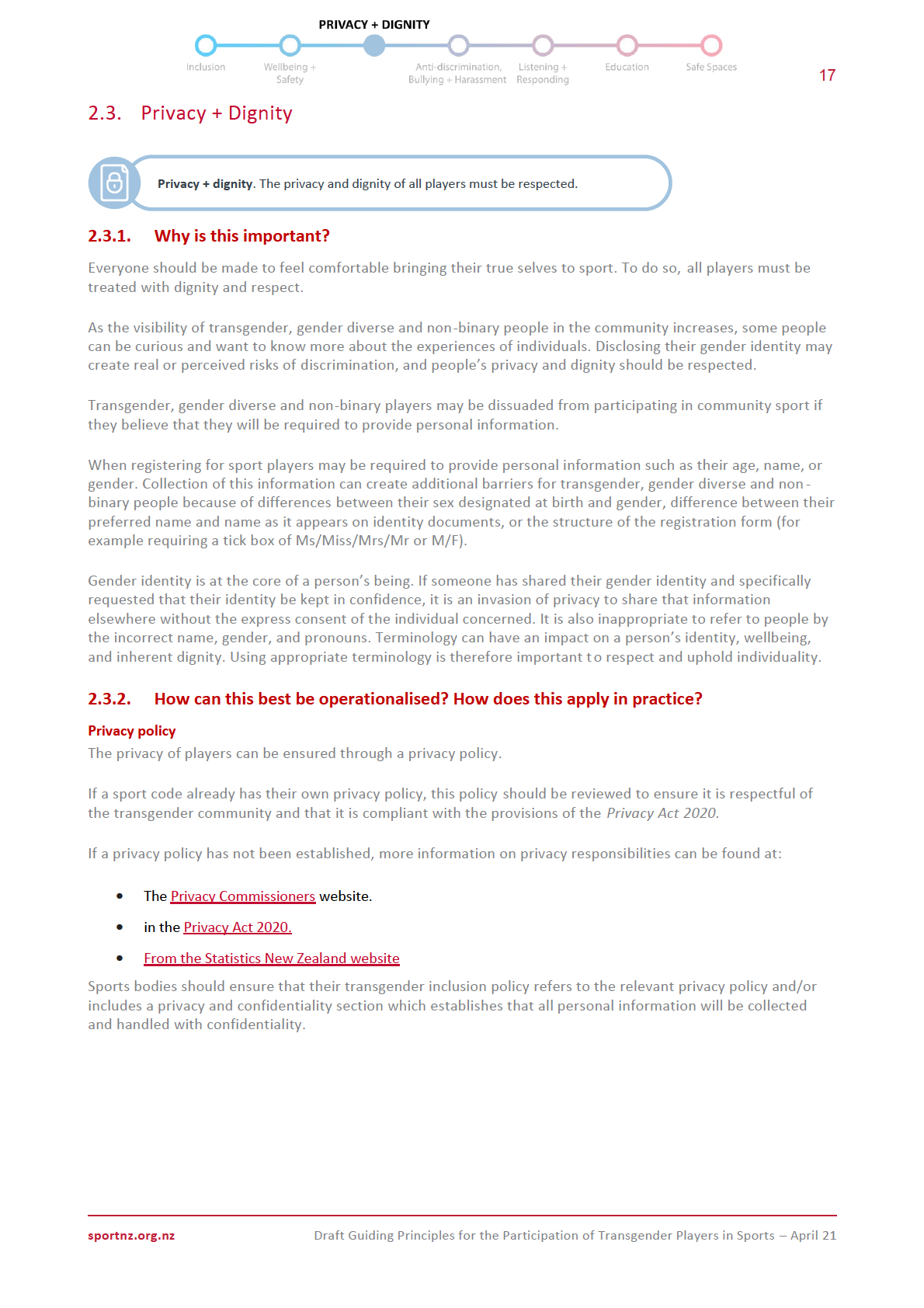

18
A strong privacy and confidentiality statement may include the following points:
• Personal information will only be collected from participants if absolutely necessary and with the
individual’s consent (or consent of the parent or guardian where the individual is under the age of
18 years).
• Any information collected, including information about an individual’s gender or sex designated at
birth, will not be used, or shared without the express consent of the individual.
• Information will be collected, held, and disclosed in accordance with the
Privacy Act 2020.
Sports bodies should also consider the type of information they are collecting an d ask themselves:
• Why do we collect this information? Is the collection of all private information necessary?
• How do we collect private information? Is it secure? Do we offer safe spaces for people to share their private
information?
• What do we do with the private information? Do we ensure that confidentiality is upheld?
• Are we inclusive in the language that we use?
Registration forms
Many sporting codes will already have established registration forms in place. Sports codes are encouraged to
consider whether the information that they are collecting with their current registration forms is necessary, and
if so, whether the language and options could be more inclusive. This could also be supported by ensuring that
correct names and pronouns are used and updated on databases, documents, and other correspondence.
Statistics New Zealand provides a step-by-step guide to determining if and how to collect data relating to sex and
gender:
• Is sex or gender information needed?
o If yes, collect data relating to sex and/or gender.
• Does collection need to identify transgender and cisgender respondents/population?
o If yes, collect ‘Two-step’ sex at birth and gender information.
• Is intersex population data needed?
o If yes, collect intersex variation data.
sportnz.org.nz
Draft Guiding Principles for the Participation of Transgender Players in Sports – April 21


20
Example of how to ask someone what pronouns they use:
Respectfully and privately use a question such as “Can I ask what pronoun you u se?”. Be
careful not to ask what pronoun someone
prefers as a person’s pronoun and identity are
not a preference.
Sports should be gender inclusive in the language that is used. This includes the language used in greeting, on signup
sheets and in publications such as on websites.
Examples of gender inclusive language:
• “Hey everyone” or “Welcome everyone” rather than “Hi guys” or “Welcome ladies and
gentlemen”.
• Using the word “partner” rather than “boyfriend/girlfriend” or “husband/wife”.
• Asking all players what pronouns they use when they register, then using these pronouns in all
verbal and written communications.
Commitment to respect individuals
Showing a commitment to uphold dignity and respect could also be reflected in a transgender inclusion policy.
Example of the member expectations from Waka Ama New Zealand and Hockey New Zealand:42,43
Treat the individual with dignity and respect.
42 Waka Ama New Zealand (n.d.)
Transgender and Transsexual Policy.
43 Hockey New Zealand (2019)
Transgender Athlete Policy Draft.
sportnz.org.nz
Draft Guiding Principles for the Participation of Transgender Players in Sports – April 21
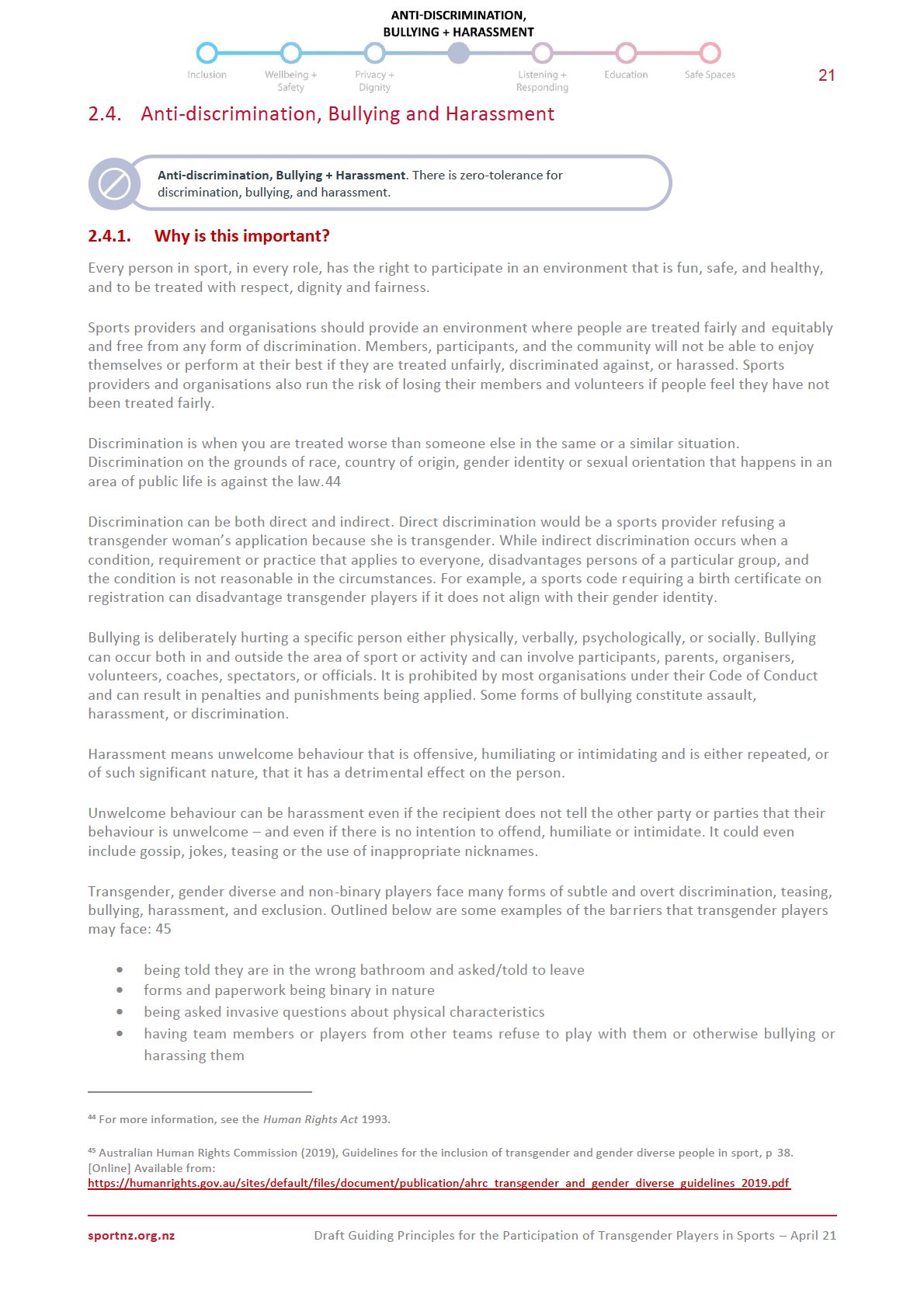

22
• having their privacy breached (for example, walked in on while in the shower)
• being intentionally addressed by incorrect pronouns (for example, calling a transgender woman or girl
‘he’).
2.4.2. How can this best be operationalised? How does this apply in practice?
Code of Conduct or Bullying and Harassment Policy
All sports should promote their organisation as one that will not allow or tolerate bullying. This could be
supported through a Code of Conduct or a policy that specifically addresses bullying behaviours, such as a
Bullying and Harassment Policy.
Sports codes should consider reviewing existing Codes of Conduct to ensure that the harassment and
discrimination of transgender, gender diverse and non-binary players is specifically addressed. Reference to anti-
discrimination should also be included in any policy specifically developed to address the inclusion of
transgender, gender diverse and non-binary players.
Good policies address a range of inappropriate behaviours including discrimination, harassment and bullying.
These policies can also provide a complaint handling process so organisations can deal with incidents of
discrimination, harassment or bullying in a practical manner that is consistent with other inappropriate
behaviour. The complaints process should also include avenues for legal redress, if appr opriate.
For assistance developing a Bullying and Harassment Policy, visit the Sport NZ website:
• Preventing Bullying and Harassment Policy
• Preventing Discrimination Policy
• Equality, Diversity, and Inclusion Policy
sportnz.org.nz
Draft Guiding Principles for the Participation of Transgender Players in Sports – April 21

23
A robust anti-discrimination and harassment policy should:
• State that discriminatory behaviour and harassment is not condoned.
• Clearly state who the policy applies to (such as coaches, umpires and other officials, staff and
administrators, spectators, players, volunteers).
• Indicate what the consequences of a breach are (for example spectators may be asked to leave
the sports ground or if the breaches are illegal, may be referred to the relevant authorities)
• Provide members with clear guidance as to where they can complain and how their complaint
will be handled.
• Communicate the policy with members. For example, clearly display that there is zero tolerance
for harassment and discrimination at the sports facility so that all members are aware. This may
include posters and flyers in the club house, kitchen and other frequently used areas.
Education
Education is also important to address discriminatory behaviour [see principle 2.6 below]. All members of the sporting
community including staff, officials, coaches, volunteers, and spectators should be educated as to what behaviour is
considered harmful and inappropriate, and to help members identify ways that they can be an ally to the transgender
community.
Scenario of the benefit of a good anti-discrimination and harassment policy:
• Sam is a young transgender female who plays football. When playing a game against another
local team one of the opposition players starts yelling offensive things at her and saying that she
should not be playing in their competition.
• Sam is upset and is unsure whether there is anything she can do about it. Her coach notices that
she is upset and talks with Sam about what happened. The coach reminds Sam that bullying is
not tolerated on or off the field and offers her support.
• Following their club Bullying and Harassment Policy, the coach talks with Sam about the
possibility of meeting with the opposition coach and player. Sam decides she does not want to
meet with the player but would like her coach to speak to the other player. Sam’s coach
therefore arranges a meeting with the opposition coach and player to discuss the incident. The
opposition coach advises that the player has received a warning.
• The player apologises for their actions and writes a letter of apology to Sam.
sportnz.org.nz
Draft Guiding Principles for the Participation of Transgender Players in Sports – April 21
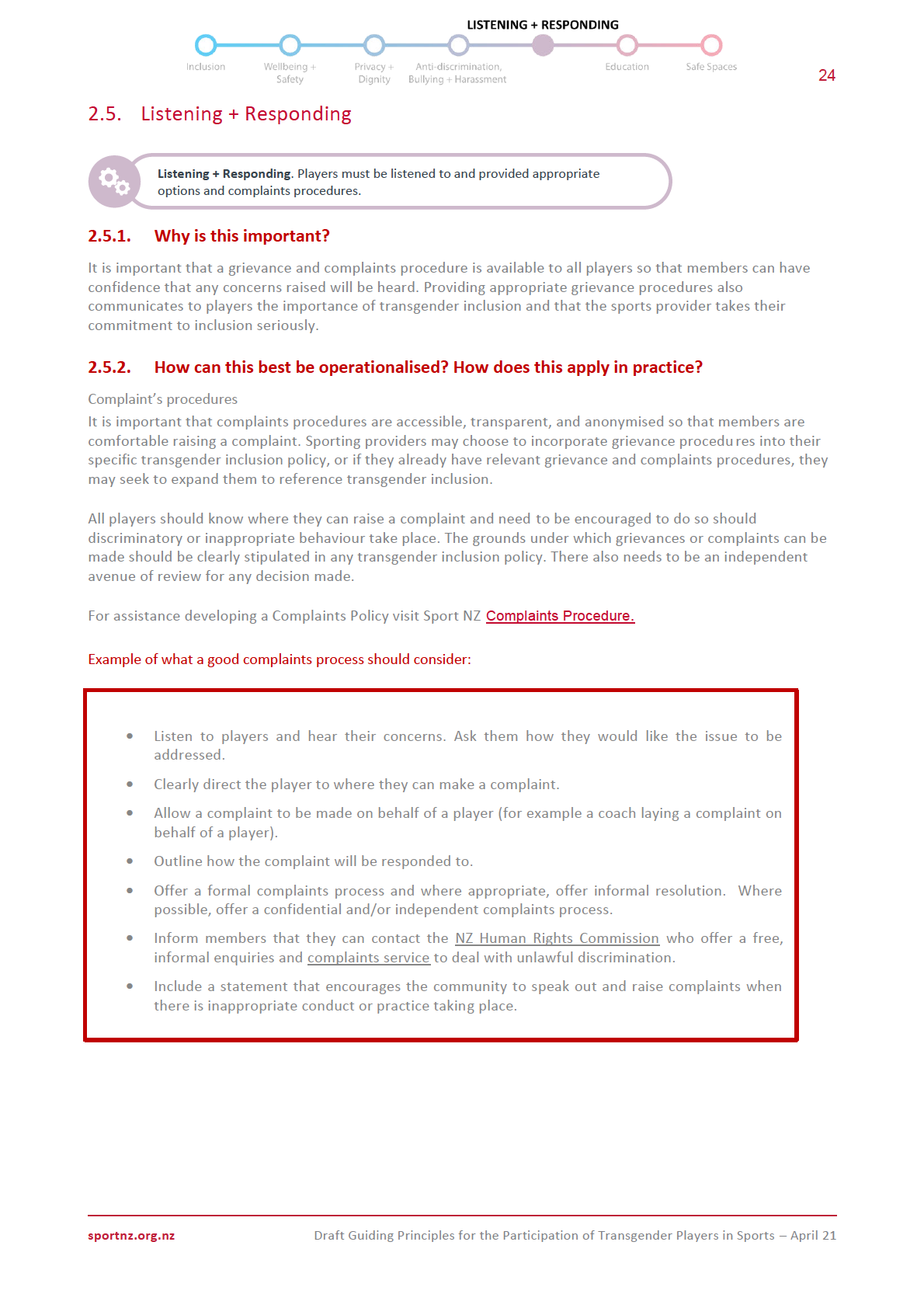
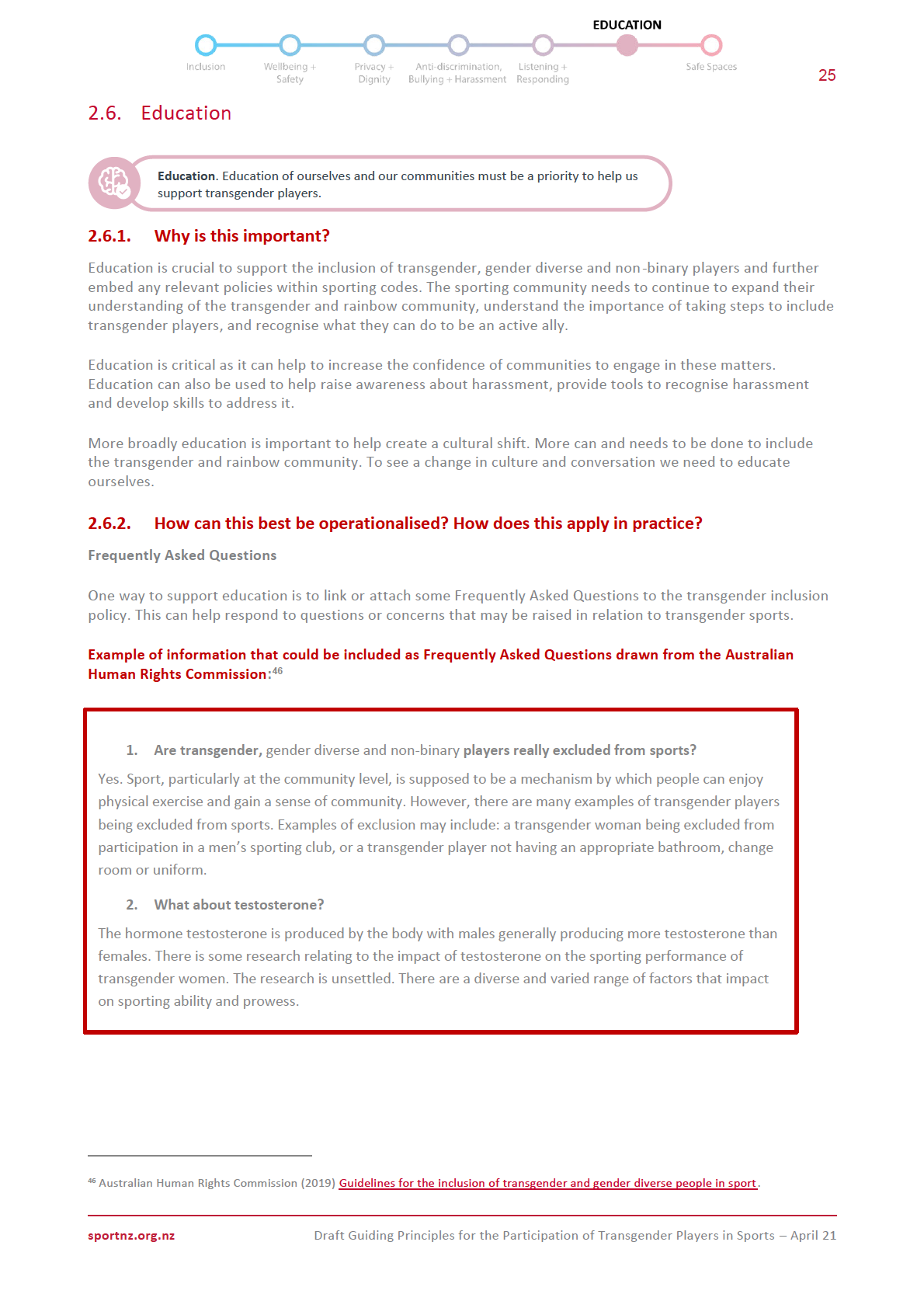

26
3. What about safety?
In considering the safety of players at the community level, a multifaceted view should be taken which
includes the physical, psychological, and cultural safety of all players.
The gender identity of a player does not create a danger or risk to safety. Transgender players, as with all
cisgender players, are diverse and varied in their height, weight, strength, and stamina. Depending on the
sport, mismatches or significant disparities among players may contribute to a risk to safety. Various sports
have age and weight restrictions to reduce mismatches and any subsequent injuries that may arise. In some
sporting codes, there is a long-established acceptance of physical mismatches, such as basketball.
Sports often have codes of conduct which include principles of fairness and respect, as well as rules for
participation in the game. All players must know the rules of the game, and participate in the sport with
informed consent, knowing that injury is an inherent risk when playing sport. If rough conduct or unsafe play
occurs, the code of conduct or rules of the relevant sporting code should be enacted, and players should be
penalised appropriately to ensure the safety of all players.
Commitment to education
A strong transgender inclusion policy would include a commitment to continuing education. Sports should engage
with resources and information that are available about the transgender community and provide links to members so
they can access the information themselves.
Example of a commitment to education from Waka Ama New Zealand and Hockey New Zealand: 47,48:
Waka Ama is committed to educate the membership about trans identified and principles
of transgender inclusion. If any clubs need support in this area Waka Ama NZ will do all
they can to assist.
Link to further resources
Another way to support education is to provide links to relevant resources.
For example, for further information and resources visit the following sites:
• Drug Free Sport NZ – New Zealand’s national anti-doping organisation.
• F’INE – a Pasifika LGBTQI-focussed provider, providing whānau ora navigational services in the Auckland
region.
47 Waka Ama New Zealand (n.d.)
Transgender and Transsexual Policy.
48 Hockey New Zealand (2019)
Transgender Athlete Policy Draft.
49 Waka Ama New Zealand (n.d.)
Transgender and Transsexual Policy.
50 Hockey New Zealand (2019)
Transgender Athlete Policy Draft.
sportnz.org.nz
Draft Guiding Principles for the Participation of Transgender Players in Sports – April 21
27
• Gender Minorities Aotearoa – a cross cultural, transgender-led organisation that operates on a Kaupapa
Māori public health framework. It provides research, information and resources, advocacy, education and
training, support, and referrals to other services.
• How to be a trans ally – a resource created in collaboration with Lush and InsideOUT is a simple guide
about how to be a great ally to the transgender and gender diverse communities.
• InsideOUT – works to give rainbow young people in Aotearoa New Zealand a sense of safety and belonging
in their schools and communities.
• NZ Human Rights Commission – advocate for the fair treatment of all members of the LGBTQI+ community.
The Human Rights Commission offers a free, informal enquiries and complaints service to deal with
unlawful discrimination.
• OUTLine – confidential, free, LGBTQ+ affirming support line and face-to-face counselling.
• Rainbow YOUTH – a charitable organisation dedicated to helping young queer and gender diverse people
up to the ages of 27, as well as their wider communities.
• Sport New Zealand – is the kaitiaki of the play, active recreation and sport system in Aotearoa New
Zealand.
sportnz.org.nz
Draft Guiding Principles for the Participation of Transgender Players in Sports – April 21
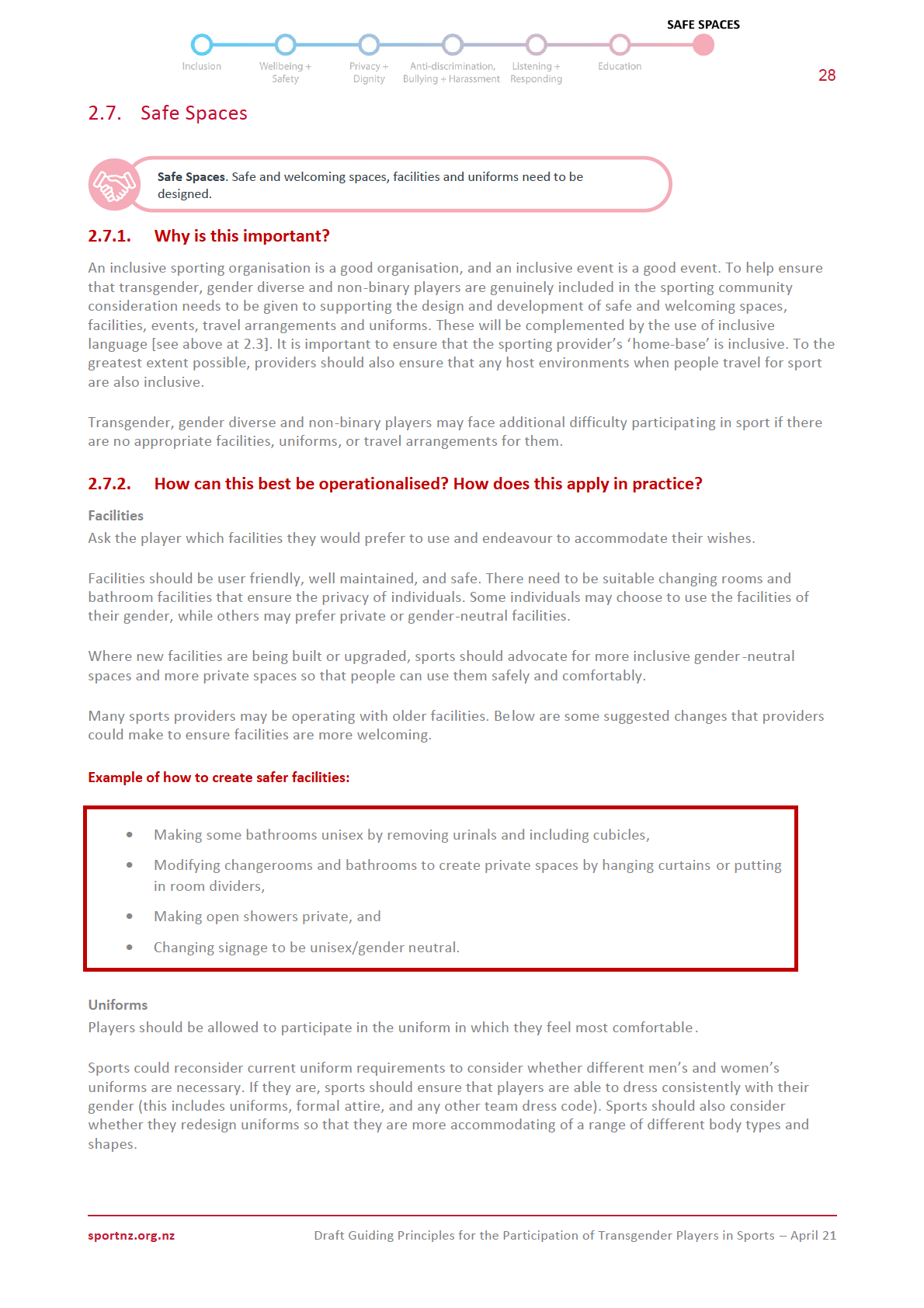

29
Travel
Sports are encouraged to be proactive when taking trips and to consider where a transgender, gender diverse
and non-binary player would like to stay and to endeavour to accommodate those wishes.
sportnz.org.nz
Draft Guiding Principles for the Participation of Transgender Players in Sports – April 21
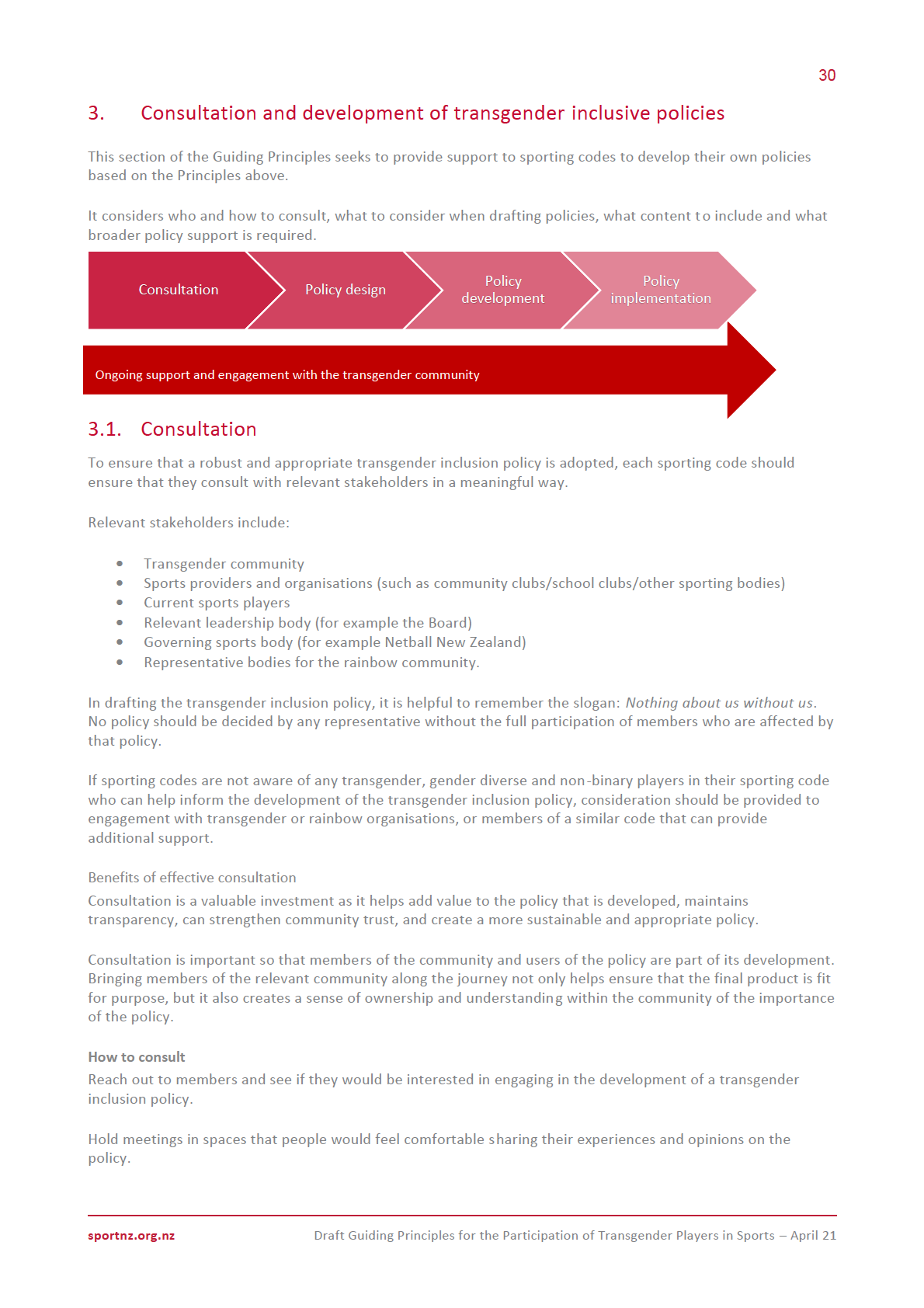
31
Be tactful in the questions asked. A transgender person’s experience is personal, so be respectful of their privacy
and the information that they choose to share.
3.2. Drafting considerations
• Make sure the transgender inclusion policy is written in plain and simple language. The policy should be able
to be picked up by community sports organisers and applied.
• Ensure that any linked policies (for example a privacy policy or health and safety policy) are updated and
inclusive of the transgender community.
• Be clear who the policy applies to. For example, clubs, organisers/administrators, officials/referees, coaches,
players, families, and spectators.
• Establish the scope of the policy. A sticking point for many sporting codes will be determining at what level the
community game ends. Community sport in New Zealand can quickly become competitive and there is no one
size fits all approach. The line between community and elite/competitive sport should be made clear in the
relevant policy.
Codes are encouraged to include an Appendix to the policy which establishes what
grades/competitions/teams are considered within the scope of the policy. Including this list as an Appendix
allows for the list to be amended and updated.
Competitions, leagues, or events that would not be subject to the policy may include events for those seeking
representative selection to national teams that would compete in competitions governed by the code’s
international sporting body.
• Determine how often the policy will be reviewed to ensure that it remains relevant. For example, it may be
reviewed annually.
3.3. Content
In developing a transgender player policy, consider the Guiding Principles and the discussion about how they can
best be operationalised and applied in practice.
A summary of the relevant elements to consider to ensure a robust transgender inclusion policy are outlined in
Table 1 below.
sportnz.org.nz
Draft Guiding Principles for the Participation of Transgender Players in Sports – April 21
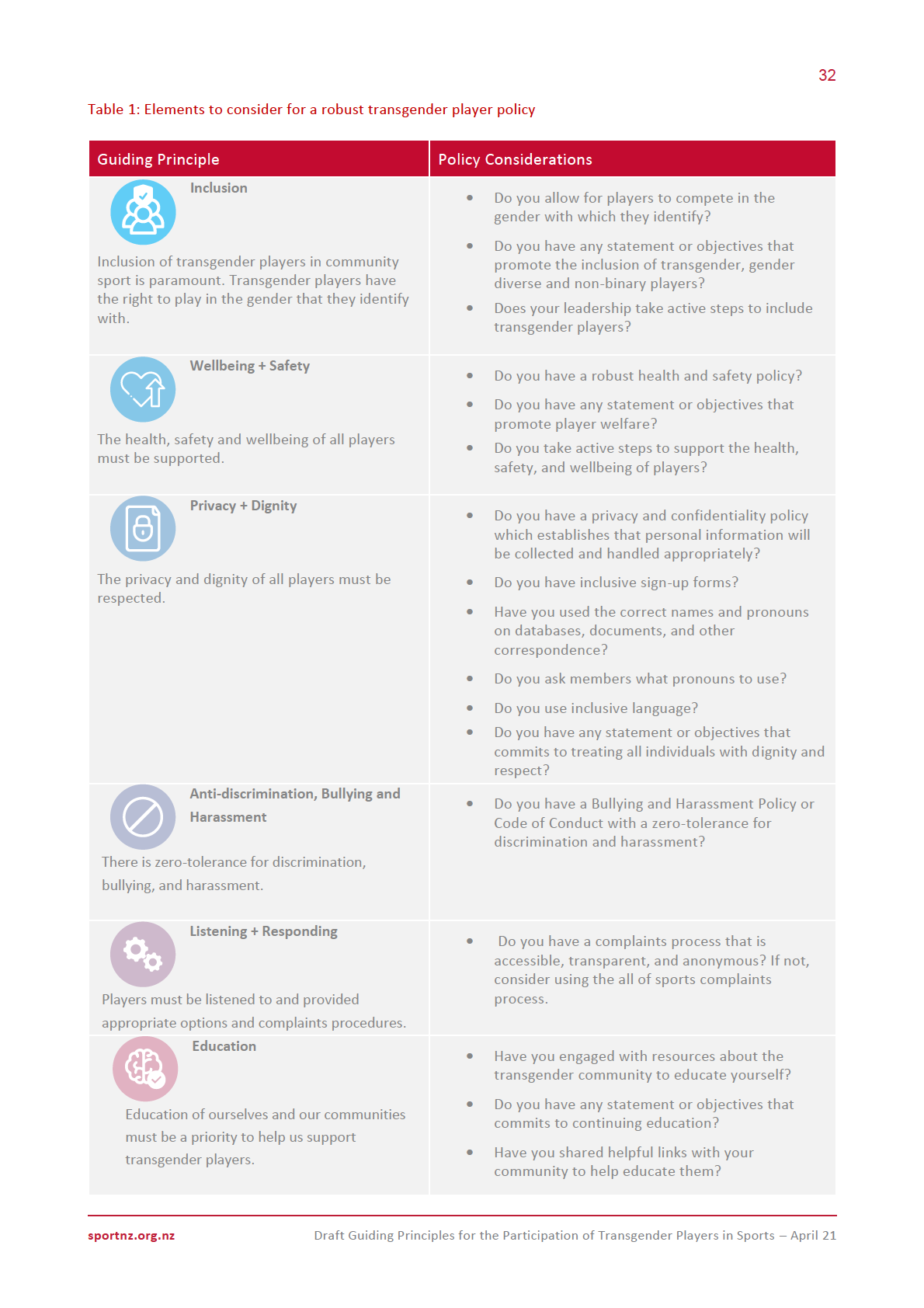

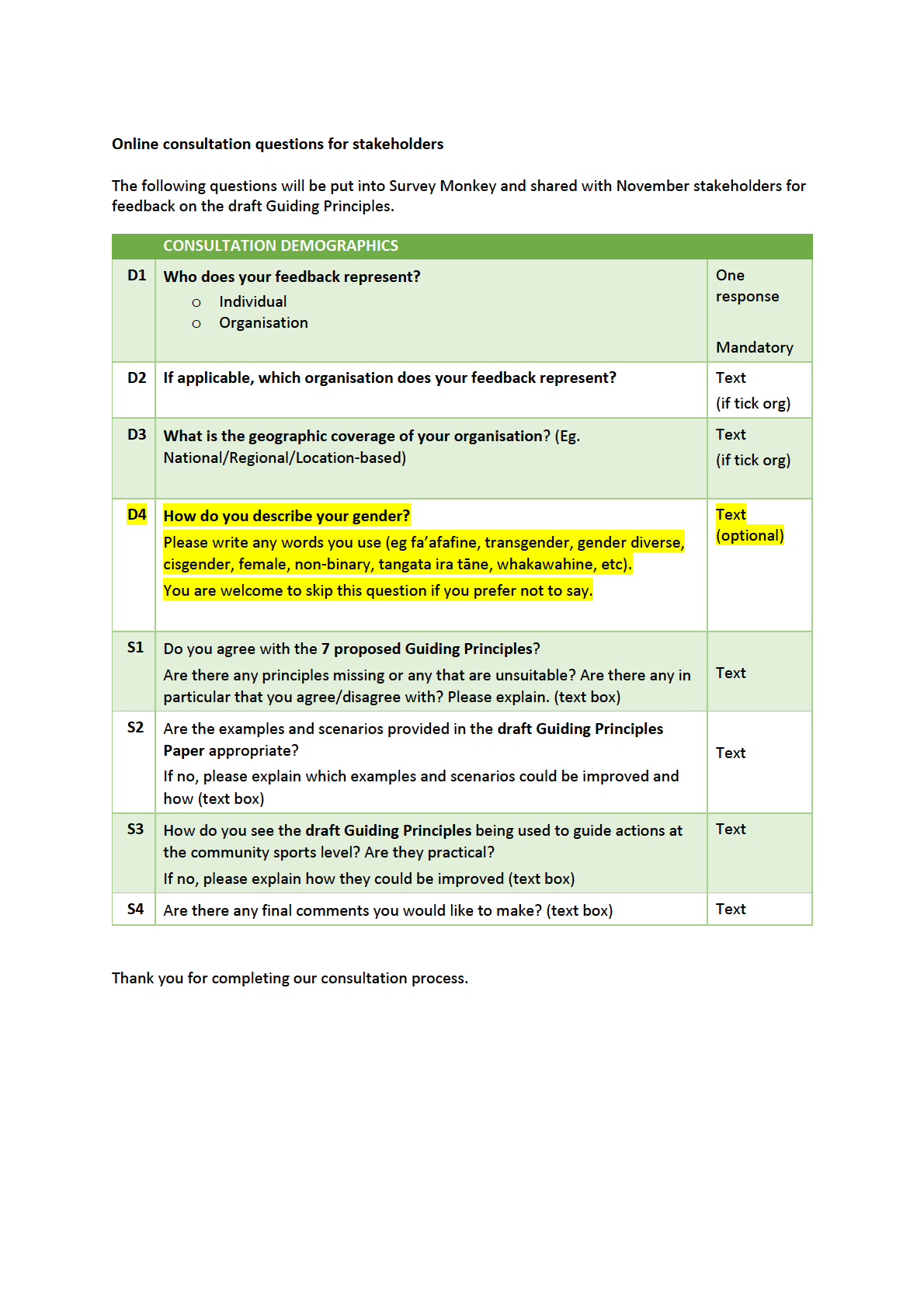
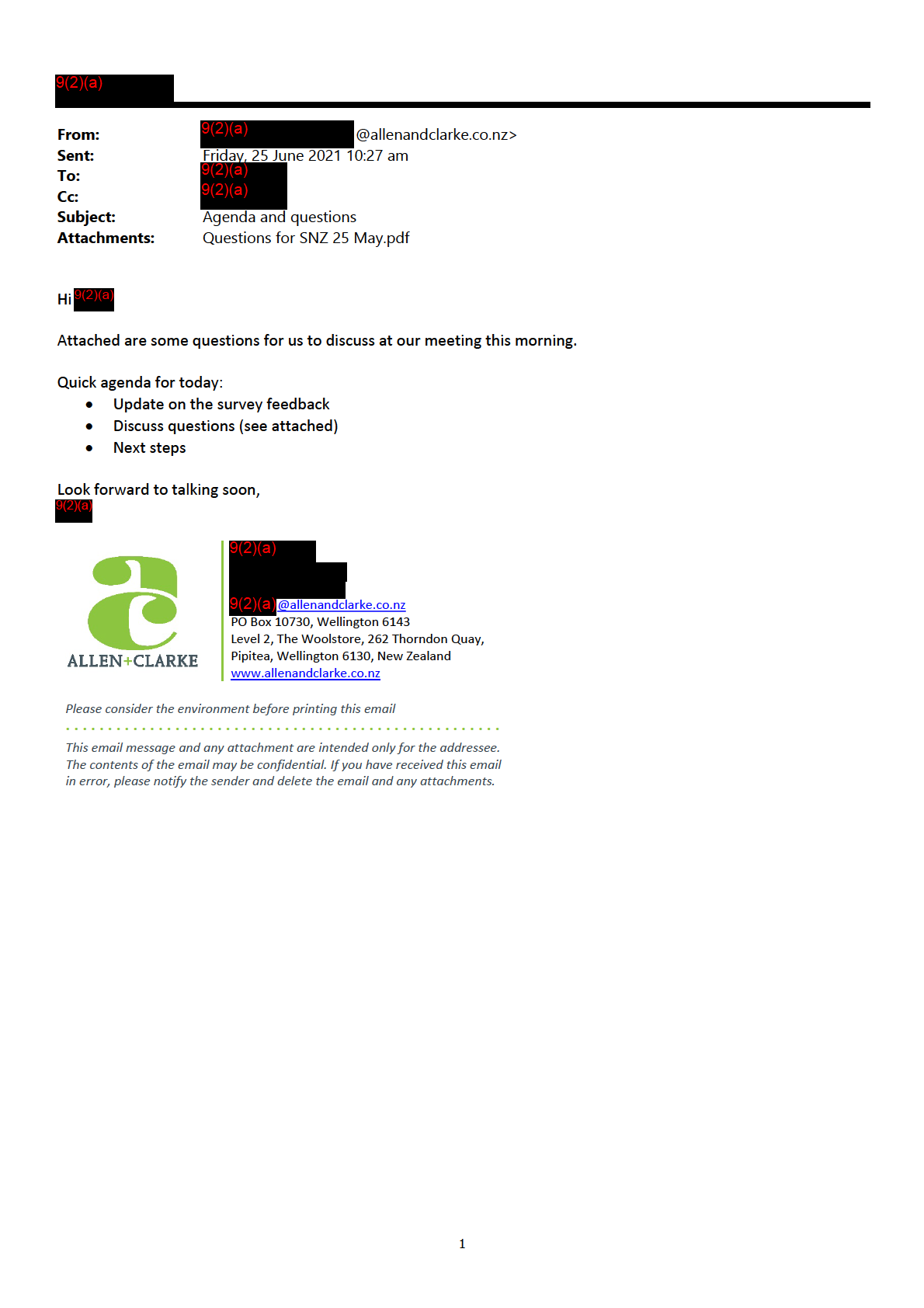
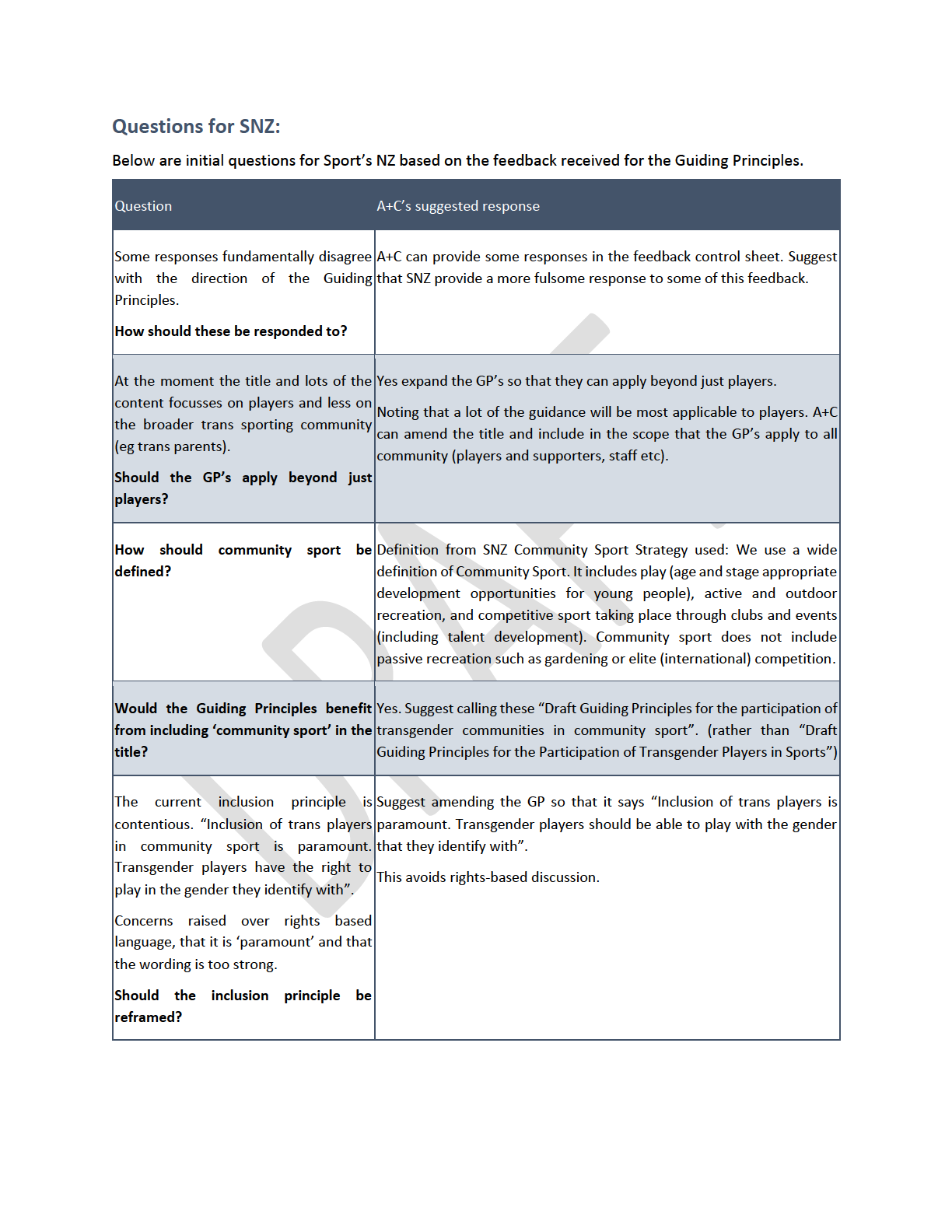
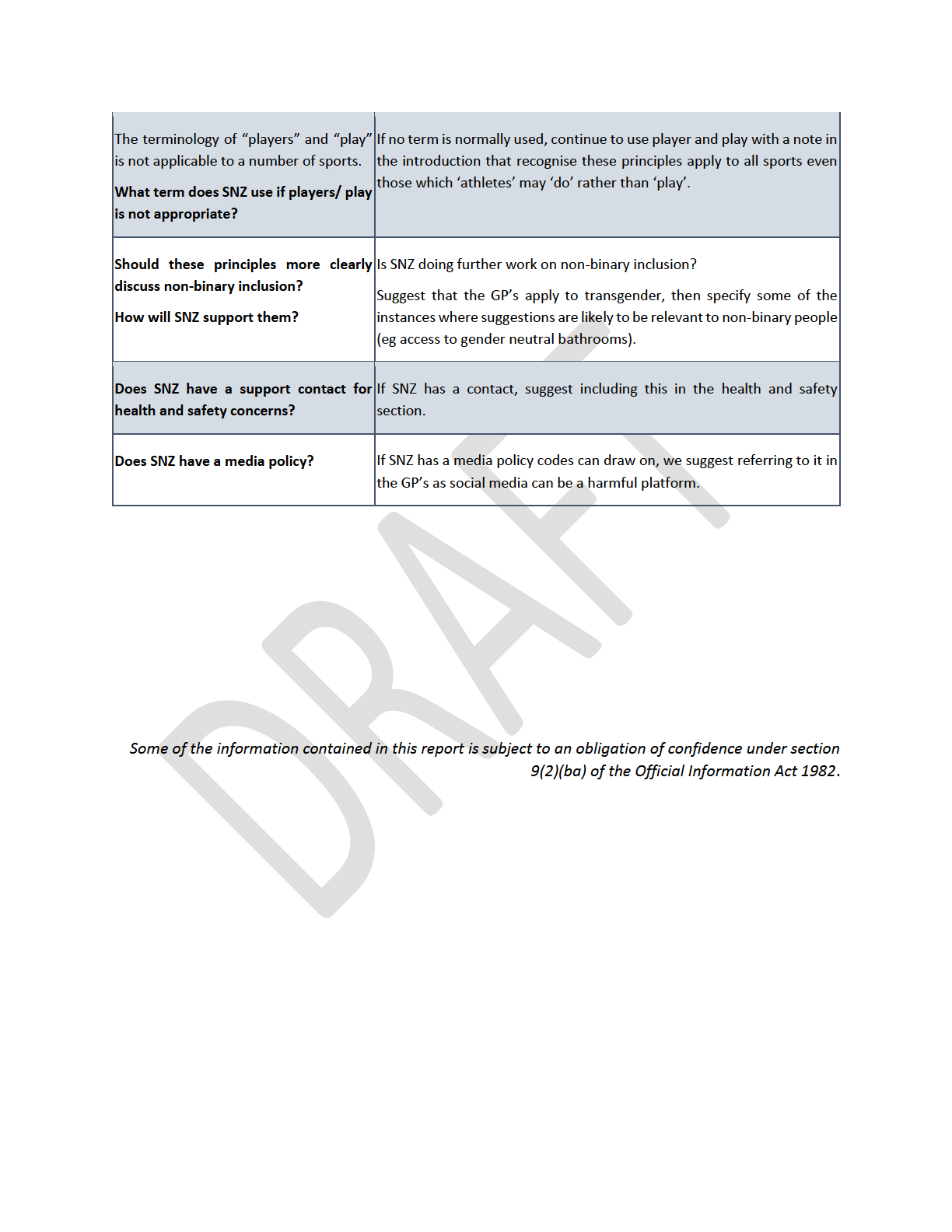
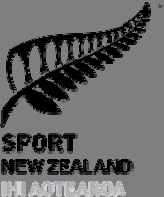




9(2)(a)
From:
9(2)(a)
Sent:
Friday, 25 June 2021 12:19 pm
To:
9(2)(a)
Subject:
Links discussed this morning
Morning 9(2)(a)
,
As discussed this morning a couple of quick links – the integrity policies for health and safety and digital media
policies etc:
https://sportnz.org.nz/integrity/
And if you wanted to watch the Minister at the Estimates hearing the link is: https://fb.watch/6kSorVAXCg/ ‐ there’s
a reasonably long discussion between the Minister and Louise Upston on the principles – I think it’s the second or
third question asked.
I’m just chasing up definitions/wording on ‘community sport’ and players/participants.
9(2)(a)
Senior Policy Advisor
9(2)(a)
sportnz.org.nz
1
















































